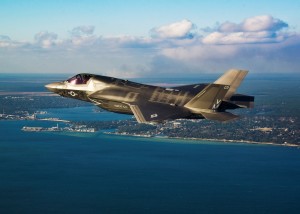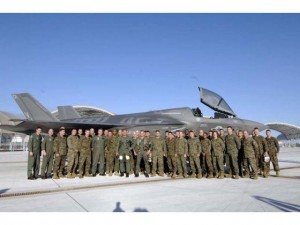01/17/12 During Second Line of Defense visits in mid-January 2012 to the participants in Bold Alligator, we were able to focus on the meaning of the arrival of the new USMC F-35Bs to Eglin AFB. Col. Arthur TOMASSETTI, vice commander of the 33rd Fighter Wing, Air Education and Training Command, Eglin Air Force Base, Fla. The 33rd Fighter Wing serves as the home to the Joint Strike Fighter Integrated Training Center, providing pilot and maintenance training for nine international partners.
http://www.eglin.af.mil/library/biographies/bio.asp?id=13376
Col. Tomassetti explained in a phone interview the meaning of the event and the way ahead.

SLD: We have seen the pictures of the planes landing. But what should folks understand when they see THESE planes landing at Eglin?
Col Tomassetti: The airplanes are the things that we take the pictures of. They’re the things that you see on YouTube.
What you don’t get to see in some of those pictures is the faces of all the Marines in VMFAT-501. You didn’t get to see the photo that got taken just before the sunset with all of those Marines that are here in that squadron standing in front of their first airplane. There was a tangible sense of pride you could feel just walking through the building that evening and the next day.
I walked away from that whole experience yesterday knowing the real story is the pride of those Marines and quite honestly the whole 33rd Fighter Wing Team here in Eglin gets a piece of that. Now we can stop talking about what we can do and start showing what we can do. We move out of the planning phase and in to the execution phase. We get to demonstrate that we have taken full advantage of the time we have had to prepare by safely and efficiently getting ourselves to the a Ready for Training declaration.
Our maintainers, both the Lockheed maintainers who are with us in the beginning and the Marine maintainers who will learn from them as we go, basically get to start this morning step one of a long list of things to get through, but they get to start step one because the airplanes are here now, and that gives them purpose. That gives them direction. That gives them motivation. You name all the buzz words you want, but now they get to show why they were selected to come here and what they can do now that they have their opportunity.

SLD: What happens next?
Col Tomassetti: Basically, what we do now is the Lockheed maintainers who are going to maintain the airplane in the beginning need to get their hands-on training with the airplanes. They’ve done all the classroom work. They’ve done all the over-the-shoulder work at the test sites. Now they get their hands-on training and they become experts.
The very next thing they do is they start teaching our Marines those same skills. And then our Marines will then start teaching other Marines and we start with the business of the 33rd Fighter Wing and the business of 501which is training pilots and maintainers for this weapon system.
While that’s all going on concurrently, we will be validating all of the technical data for the F-35B, just like we’ve done for the F-35As that we’ve had here, and that means we’re going through every single procedure from simple things like open and close the canopy to the more complex things like remove and replace the engine and we’re going to go through and make sure that the procedures are written correctly.
We will make sure that the steps are sequenced, not only correctly, but they’re sequenced and optimized in an efficient way to get the job done. Our folks will stamp them good-to-go and say that, yes, these are good and we will be able to use these procedures.
That will be the core of what the next 60 days or so will look like with the airplanes here, and then hopefully we will have a flight clearance from NAVAIR and we will start the flying the airplanes.
Once flight operations begin, we’ll get to characterize our airplanes, understand what we have, learn specific details of each tail number to ensure we understand each airplane, not just the F-35B, but we understand each one of our tail numbers, exactly what we have in each one.
Then once we have that, we’ll start the pilot side of the training program. The first two instructor pilots will get their warm-up and they’ll execute all the initial syllabus tasks, make sure everything is good to go.
Once we get the clearance to start training, we’ll start the first class of students going through the training syllabus, and then quite honestly past that, it starts to become I think sort of business-as-usual in a training command. We will start getting pilots and maintainers in the front door who are untrained and we will start turning them out the other end as trained pilots or maintainers and send them off to operating bases, operational test, wherever the need is.
SLD: The broad point is these two new aircraft, which go into the Marine Corps inventory as operational aircraft allows you to move out into a new period, into the F-35 period basically. You are stepping into the new era now for sure.
Col Tomassetti: Absolutely. We’re going to operate now the way the Marines will operate this airplane everywhere we go and in the future. It’s not the same as what’s happening at a test location. They operate under a different set of rules and a different set of processes because they have to in order to do their job. We have to maintain the airplanes and understand the airplanes the way an operating squadron needs to understand and maintain its airplanes. This basically means we’re going to take whatever’s been done so far with F-35 and Marine-ize it, if that’s even a word. We’re going to understand the airplane differently than they understand it at the test sites. We’re going to understand it in terms of how a Marine maintainer on a Marine flight line or on a ship or at an expeditionary location thinks about their airplane and we’re going to think about our airplanes that way.
SLD: Over the next two years you will be working with the Lockheed maintainers to shape a new approach for the USMC and to shape a new public-private partnership with regard to the maintenance approach. Could you describe this aspect of the way ahead?
Col Tomassetti: We are dependent on Lockheed because of the construct of this contract for next two years ahead. As we look at it from a business case analysis standpoint, when you look at Eglin. Eglin’s kind of unique in the world. We have three versions of the airplane at this one facility and will be training pilots and maintainers. We are what you might consider a prime location where our maintenance could be a hybrid of organic and contractor.
Today, we are leveraging Lockheed’s ability to cross-train people to work on all three variants of the airplanes on the flight line and in the back shops. As we transition to organic maintenance and get our military maintainers doing the front line maintenance activities we should look at where there might be potential to take advantage of contractor maintenance and what they bring to the table in terms of expertise and efficiencies.
As an example, capabilities that would’ve resided in the MALS (Marine Aviation Logistics Squadron) in the Marine Corp and other places, we may find that the contractor is able to do that same job with less people than we would utilize. We’re kind of an optimal place here at Eglin for someone to say, “Hey, there’s some efficiencies to be gained here if we can come up with some kind of hybrid solution,” rather than pursuing separate USAF, USN, USMC and International approaches to maintenance. We have the opportunity, given the unique set up at Eglin, to explore all aspects of integration for the F-35 weapon system amongst the US Services, with our coalition partners, and with our contractor team. Integrated solutions will help us reduce cost, increase effectiveness and maximize the commonality and interoperability built into this system.
SLD: Next up is clearance for flight and that will be another key milestone for the USMC operated aircraft.
Col Tomassetti: The next milestone for us obviously is getting flight operations going and I think is really the key. The start date has become very difficult to predict because it’s not following a typical legacy process. We are on an event driven timeline with established milestones and decision points that allow us to assess the readiness of the airplane and the people to begin the training mission. This method makes it difficult to predict specific dates but does ensure that we progress safely, methodically and effectively.
For earlier discussions with Col. Tomassetti please see the following:
https://www.sldinfo.com/the-f-35-at-eglin/
https://www.sldinfo.com/the-f-35-in-history-a-day-for-col-tomassetti-to-remember/
https://www.sldinfo.com/an-update-from-eglin-on-the-arrival-of-the-f-35/
https://www.sldinfo.com/an-update-on-the-eglin-f-35-training-facility/

